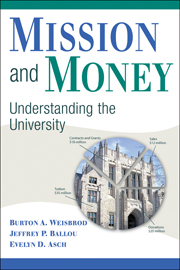Book contents
- Frontmatter
- Contents
- Illustrations
- Preface
- 1 An Introduction to the Higher Education Industry
- 2 The Higher Education Business and the Business of Higher Education – Now and Then
- 3 Is Higher Education Becoming Increasingly Competitive?
- 4 The Two-Good Framework: Revenue, Mission, and Why Colleges Do What They Do
- 5 Tuition, Price Discrimination, and Financial Aid
- 6 The Place of Donations in Funding the Higher Education Industry
- 7 Endowments and Their Management: Financing the Mission
- 8 Generating Revenue from Research and Patents
- 9 Other Ways to Generate Revenue – Wherever It May Be Found: Lobbying, the World Market, and Distance Education
- 10 Advertising, Branding, and Reputation
- 11 Are Public and Nonprofit Schools “Businesslike”? Cost-Consciousness and the Choice between Higher Cost and Lower Cost Faculty
- 12 Not Quite an Ivory Tower: Schools Compete by Collaborating
- 13 Intercollegiate Athletics: Money or Mission?
- 14 Mission or Money: What Do Colleges and Universities Want from Their Athletic Coaches and Presidents?
- 15 Concluding Remarks: What Are the Public Policy Issues?
- Appendix
- References
- Index
12 - Not Quite an Ivory Tower: Schools Compete by Collaborating
Published online by Cambridge University Press: 17 July 2009
- Frontmatter
- Contents
- Illustrations
- Preface
- 1 An Introduction to the Higher Education Industry
- 2 The Higher Education Business and the Business of Higher Education – Now and Then
- 3 Is Higher Education Becoming Increasingly Competitive?
- 4 The Two-Good Framework: Revenue, Mission, and Why Colleges Do What They Do
- 5 Tuition, Price Discrimination, and Financial Aid
- 6 The Place of Donations in Funding the Higher Education Industry
- 7 Endowments and Their Management: Financing the Mission
- 8 Generating Revenue from Research and Patents
- 9 Other Ways to Generate Revenue – Wherever It May Be Found: Lobbying, the World Market, and Distance Education
- 10 Advertising, Branding, and Reputation
- 11 Are Public and Nonprofit Schools “Businesslike”? Cost-Consciousness and the Choice between Higher Cost and Lower Cost Faculty
- 12 Not Quite an Ivory Tower: Schools Compete by Collaborating
- 13 Intercollegiate Athletics: Money or Mission?
- 14 Mission or Money: What Do Colleges and Universities Want from Their Athletic Coaches and Presidents?
- 15 Concluding Remarks: What Are the Public Policy Issues?
- Appendix
- References
- Index
Summary
In the competitive struggle for revenue to advance its mission, a college or university – as a firm in any other industry – has the incentive to not simply “go it alone” but also to reach out for alliances. Even the strongest and wealthiest schools are continually searching for ways to strengthen their competitive position. In the competition for students, even for traditional students, it is clear that no college or university can provide everything it needs to achieve its educational mission – at least not efficiently. Engineering students, for example, may benefit substantially from internship experience with a private construction firm, and faculty researchers in biochemistry may benefit from collaboration with researchers at pharmaceutical laboratories. A school could not efficiently provide those opportunities by operating its own construction and pharmaceutical research firms, and so they engage in “outsourcing,” turning to other schools, private businesses, and governmental agencies.
Collaborations of colleges and universities with other schools, private firms, and governments are both mission driven and revenue driven. A school can be expected to take advantage of all sorts of opportunities, including collaborating with other organizations, collegiate or otherwise, when that will generate revenue or otherwise advance the mission. They collaborate with each other when that will help them compete more effectively against other schools. They collaborate with private firms outside education, with nonprofit organizations, and with governments at various levels and with any other organizations if that will provide revenue or opportunity.
- Type
- Chapter
- Information
- Mission and MoneyUnderstanding the University, pp. 206 - 217Publisher: Cambridge University PressPrint publication year: 2008

